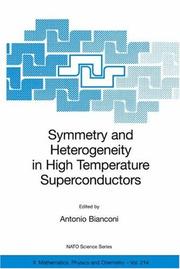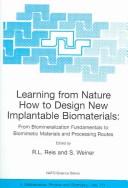| Listing 1 - 6 of 6 |
Sort by
|
Periodical
Abstract | Keywords | Export | Availability | Bookmark
 Loading...
Loading...Choose an application
- Reference Manager
- EndNote
- RefWorks (Direct export to RefWorks)
"Ceramics International primarily deals with the fundamental aspects of ceramic science and their application to the development of improved ceramic materials. The journal particularly encourages papers that show how ceramic science can be used to improve the quality, reliability and performance of ceramics through the development of advanced materials and manufacturing techniques."
keramiek --- Physics --- Chemical technology --- Ceramics --- Céramique industrielle --- Periodicals. --- Périodiques --- Céramique industrielle --- #TS WBIB --- 669 --- Metallurgy --- Periodicals --- Chemistry --- Chemical Engineering --- 669 Metallurgy

ISBN: 1402039883 1402039875 1402039891 9786610611454 1280611456 Year: 2006 Volume: 214 Publisher: Brussels Dordrecht Nato Public Diplomacy Division Springer
Abstract | Keywords | Export | Availability | Bookmark
 Loading...
Loading...Choose an application
- Reference Manager
- EndNote
- RefWorks (Direct export to RefWorks)
Talks about quantum mechanism that allows the macroscopic quantum coherence of a superconducting condensate to resist to the attacks of high temperature. This book presents the experimental results on nanoscale phase separation and the two component scenario in high Tc in doped cuprate and the lower symmetry in the superconducting elements.
High-temperature superconductivity --- Symmetry (Physics) --- Supraconductivité à hautes températures --- Symétrie (Physique) --- Congresses --- Congresses. --- Congrès --- High temperature superconductivity. --- High temperature superconductivity --- Electricity & Magnetism --- Physics --- Physical Sciences & Mathematics --- Supraconductivité à hautes températures --- Symétrie (Physique) --- Congrès --- EPUB-LIV-FT LIVCHIMI SPRINGER-B --- Materials science. --- Inorganic chemistry. --- Structural materials. --- Nanotechnology. --- Metals. --- Materials Science. --- Structural Materials. --- Metallic Materials. --- Ceramics, Glass, Composites, Natural Methods. --- Inorganic Chemistry. --- Materials. --- Chemistry, inorganic. --- Ceramics, Glass, Composites, Natural Materials. --- Inorganic chemistry --- Chemistry --- Inorganic compounds --- Molecular technology --- Nanoscale technology --- High technology --- Engineering --- Engineering materials --- Industrial materials --- Engineering design --- Manufacturing processes --- Materials --- Ceramics. --- Glass. --- Composites (Materials). --- Composite materials. --- Composites (Materials) --- Multiphase materials --- Reinforced solids --- Solids, Reinforced --- Two phase materials --- Amorphous substances --- Ceramics --- Glazing --- Ceramic technology --- Industrial ceramics --- Keramics --- Building materials --- Chemistry, Technical --- Clay --- Metallic elements --- Chemical elements --- Ores --- Metallurgy --- Architectural materials --- Architecture --- Building --- Building supplies --- Buildings --- Construction materials --- Structural materials

ISBN: 1402026447 1402026471 9786610190652 1280190655 140202648X Year: 2004 Volume: 171 Publisher: Dordrecht ; Boston ; London Brussels Kluwer Academic Publishers NATO Scientific Affairs Division
Abstract | Keywords | Export | Availability | Bookmark
 Loading...
Loading...Choose an application
- Reference Manager
- EndNote
- RefWorks (Direct export to RefWorks)
The development of materials for any replacement or regeneration application should be based on the thorough understanding of the structure to be substituted. This is true in many fields, but particularly exigent in substitution and regeneration medicine. The demands upon the material properties largely depend on the site of application and the function it has to restore. Ideally, a replacement material should mimic the living tissue from a mechanical, chemical, biological and functional point of view. Of course this is much easier to write down than to implement in clinical practice. Mineralized tissues such as bones, tooth and shells have attracted, in the last few years, considerable interest as natural anisotropic composite structures with adequate mechanical properties. In fact, Nature is and will continue to be the best materials scientist ever. Who better than nature can design complex structures and control the intricate phenomena (processing routes) that lead to the final shape and structure (from the macro to the nano level) of living creatures? Who can combine biological and physico-chemical mechanisms in such a way that can build ideal structure-properties relationships? Who, else than Nature, can really design smart structural components that respond in-situ to exterior stimulus, being able of adapting constantly their microstructure and correspondent properties? In the described philosophy line, mineralized tissues and biomineralization processes are ideal examples to learn-from for the materials scientist of the future.
Biomineralization --- Prosthesis Design --- Biological compatibility --- Biological tolerance --- Biomedical compatibility --- Biomedical tolerance --- Biotolerance --- Compatibility, Biological --- Compatibility, Biomedical --- Tolerance, Biological --- Tolerance, Biomedical --- Biomedical materials --- Biocompatibility --- Engineering. --- Biotechnology. --- Biochemical engineering. --- Inorganic chemistry. --- Materials science. --- Engineering, general. --- Biochemical Engineering. --- Inorganic Chemistry. --- Characterization and Evaluation of Materials. --- Ceramics, Glass, Composites, Natural Methods. --- Material science --- Physical sciences --- Inorganic chemistry --- Chemistry --- Inorganic compounds --- Bio-process engineering --- Bioprocess engineering --- Biochemistry --- Biotechnology --- Chemical engineering --- Genetic engineering --- Construction --- Industrial arts --- Technology --- Chemistry, inorganic. --- Surfaces (Physics). --- Ceramics, Glass, Composites, Natural Materials. --- Physics --- Surface chemistry --- Surfaces (Technology) --- Ceramics. --- Glass. --- Composites (Materials). --- Composite materials. --- Composites (Materials) --- Multiphase materials --- Reinforced solids --- Solids, Reinforced --- Two phase materials --- Materials --- Amorphous substances --- Ceramics --- Glazing --- Ceramic technology --- Industrial ceramics --- Keramics --- Building materials --- Chemistry, Technical --- Clay --- Implantable biomaterials --- Biomimetic materials
Periodical
ISSN: 00796700 18731619 Year: 1967 Publisher: Oxford
Abstract | Keywords | Export | Availability | Bookmark
 Loading...
Loading...Choose an application
- Reference Manager
- EndNote
- RefWorks (Direct export to RefWorks)
polymeren --- polymers --- Chemistry --- fysicochemie --- Macromolecules --- Polymers --- Polymerization --- Polymères --- Polymérisation --- Periodicals --- Périodiques --- Polymères --- Polymérisation --- #TS:WSCH --- Engineering --- Material Science and Metallurgy --- General and Others --- Polymers and Plastics --- Electronics --- Polymer Technology --- Biomaterials --- Ceramics --- Composites
Book
ISBN: 9789462700079 9462700079 9461661576 9789461661579 Year: 2014 Volume: 4 Publisher: Leuven, Belgium : Leuven University Press,
Abstract | Keywords | Export | Availability | Bookmark
 Loading...
Loading...Choose an application
- Reference Manager
- EndNote
- RefWorks (Direct export to RefWorks)
This book presents a reconstruction of the Hellenistic-Roman glass industry from the point of view of raw material procurement. Within the ERC funded ARCHGLASS project, the authors of this work developed new geochemical techniques to provenance primary glass making. They investigated both production and consumer sites of glass, and identified suitable mineral resources for glass making through geological prospecting. Because the source of the raw materials used in the manufacturing of natron glass can be determined, new insights in the trade of this material are revealed. While eastern Mediterranean glass factories were active throughout the Hellenistic to early Islamic period, western Mediterranean and possibly Italian and North African sources also supplied the Mediterranean world with raw glass in early Roman times. By combining archaeological and scientific data, the authors develop new interdisciplinary techniques for an innovative archaeological interpretation of glass trade in the Hellenistic-Roman world, highlighting the development of glass as an economic material.
Archaeogeology --- Archaeological geology --- Archeologische geologie --- Geoarchaeology --- Geological archaeology --- Géologie archéologique --- Glassware, Ancient. --- Glass manufacture --- Glassware, Roman. --- Glassware --- Glassware industry --- Glass --- Verrerie antique --- Verre --- Verrerie romaine --- Verrerie --- History --- Industrie --- Histoire --- Rome --- Middle East --- Mediterranean Region --- Moyen-Orient --- Méditerranée, Région de la --- Antiquities. --- Antiquités --- Academic collection --- 902 <3> --- Archeologie--Plaatsaanduiding van de Oude Wereld --- 902 <3> Archeologie--Plaatsaanduiding van de Oude Wereld --- Méditerranée, Région de la --- Antiquités --- Glassware, Classical. --- History. --- Roman glassware --- Glass industry --- Classical glassware --- Ancient glassware --- Amorphous substances --- Ceramics --- Glazing --- Glass trade --- House furnishings --- Table setting and decoration --- Ceramic industries --- Civilization [Greco-Roman ] --- Archeology --- High Hellenistic --- pot-metal glass
Book
ISBN: 9004204407 9786613356796 1283356791 9004217452 9789004217454 9789004204409 Year: 2012 Publisher: Boston : Brill,
Abstract | Keywords | Export | Availability | Bookmark
 Loading...
Loading...Choose an application
- Reference Manager
- EndNote
- RefWorks (Direct export to RefWorks)
The Spanish colonization dramatically interrupted the autonomous development of ancient Mesoamerican culture. Nevertheless, indigenous societies learnt to live with the conquest. It was not only a time of crisis, but also an extraordinarily creative time period in which material culture reflected indigenous peoples’ varied responses and adaptations to the changing circumstances. This work presents insights into the process of cultural continuity and change in the indigenous world by focusing on pottery technology in the Nahua (Aztec) region of Central Mexico. The late pre-colonial, early colonial and present-day characteristics of this industry are explored in order to come to a renewed understanding of its long-term development. with a contribution by Iliana Yunuen Caloca Rhi
Indian pottery --- Pottery making (Handicraft) --- Indians of Mexico --- Pottery craft --- Material culture. --- Antiquities. --- History. --- Mexico --- History --- Ceramics --- Handicraft --- Indians of North America --- Indigenous peoples --- Meso-America --- Meso-American Indians --- Mesoamerica --- Mesoamerican Indians --- Pre-Columbian Indians --- Precolumbian Indians --- Ethnology --- Pottery --- Indian pottery. --- Pottery craft. --- Conquest of Mexico (1519-1540) --- 1519 - 1810 --- Mexico. --- Indians --- Pottery, Indian --- Archaeological specimens --- Artefacts (Antiquities) --- Artifacts (Antiquities) --- Specimens, Archaeological --- Material culture --- Archaeology --- Anáhuac --- Estados Unidos Mexicanos --- Maxico --- Méjico --- Mekishiko --- Meḳsiḳe --- Meksiko --- Meksyk --- Messico --- Mexique --- República Mexicana --- Stany Zjednoczone Meksyku --- United Mexican States --- United States of Mexico --- 1519-1810
| Listing 1 - 6 of 6 |
Sort by
|

 Search
Search Feedback
Feedback About
About Help
Help News
News